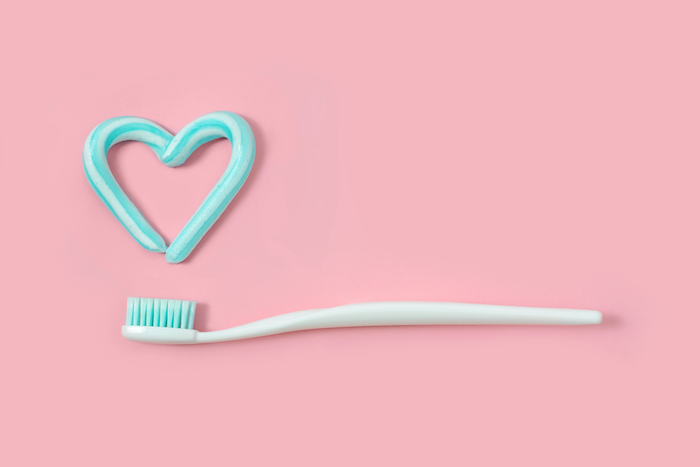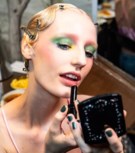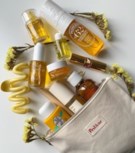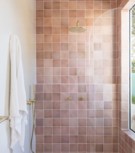STYLE
Beauty
Read this before you whiten your teeth

Want a brighter, shinier, healthier smile? We thought so. Here's all you need to know to get those teeth sparkly 'n' white.
You go to the dentist every six months (ish) and brush twice a day (usually). But when it comes to keeping your pearly whites, well, pearly, things are a bit more involved than just checkups and scrubbing sessions. Like, do you really need to floss? And do the whitening tricks you see on TikTok *really* work? Here's everything you need to know about getting healthier—and, yes, whiter—teeth.
Q: Isn't brushing basically just brushing? Like, do I need to be using a certain technique?
A: The short answer? Yes, says Dr. Lawrence Fung, dentist and founder of Silicon Beach Dental in Los Angeles. "Always brush as a 45-degree angle so the bristles can get under the gums to sweep away plaque." Brush for a total of two minutes: 30 seconds on each quadrant of your mouth (top left and right, then bottom left and right).
How do I choose a toothbrush? So. Many. Options!
Go for an electric toothbrush, says dental hygienist Jessica Morgan. "Two minutes of brushing with an electric toothbrush is more than you could do in a month with a regular brush." (Try the Philips Sonicare ProtectiveClean 4100 Rechargeable Electric Toothbrush). And regardless of whether your toothbrush is manual or electric, always opt for soft bristles (they're gentler on your teeth and gums).
Brushing right after a meal is ideal, right?
Actually, wait a bit after chowing down, advises cosmetic dentist Dr. Brian Kantor Lowenberg, Lituchy & Kantor in NYC. "Your enamel temporarily softens when you eat or drink something acidic or sweet, so waiting to brush will actually help prevent further staining and damage," he says. The ideal breather before you brush? At least 45 minutes.
Why do I need to floss if I brush twice a day?
We get it: Adding another step seems like a lot to ask. "Flossing gets rid of any gunk stuck between your teeth. It helps prevent cavities by removing food particles that can lead to tooth death," explains Dr. Fung. Bottom line? There's gross stuff your brush can't reach so, yeah, you've gotta floss.
My gums always bleed when I floss. What's up?
It's probably because you don't floss consistently, which causes some inflammation and a little bleeding in your gums. But that'll go away the more you floss. Dr. Fung recommends using a smooth, coated floss that easily slides between your teeth to gently remove all the buildup without irritating gums. (We love Cocofloss.)
"Take about 10 inches and wrap each end between your hands. Gently press down between your teeth, making sure you get under your gums as well as in all the nooks and crevices," he says.
I've got braces and flossing is so annoying. What should I do?
Yeah, weaving a piece of floss between those brackets is a real pain. What to do instead? Try a water flosser (like Waterpik). It shoots water super fast, dislodging anything stuck between your teeth. "All you have to do is hold the device, and it does the work for you," says Dr. Kantor. Just go easy, he adds: "Putting your flosser on the highest, fastest setting can cause gum damage." Ouch.
My teeth get really sensitive. What can I do?
Using a toothpaste like Sensodyne will calm the irritated nerves in your mouth. You can also try brushing with lukewarm water (vs. ice cold), advises Dr. Kantor.
What is fluoride and do I need it?
"Fluoride protects your teeth from cavity-causing bacteria by making your enamel more resistant to bacteria's acid attacks," explains Dr. Kantor. Using a fluoride toothpaste daily is safe—but be sure to only use the recommended amount on the packaging (and we're hoping we don't really need to say this, but try not to swallow your toothpaste).
Can I whiten my teeth while I have braces?
Sadly, we don't recommend it. "The brackets on your teeth will prevent any whitening ingredients from reaching that part of the tooth," says Dr. Kantor. So when you get your braces removed, the color of your teeth won't be even—which is really hard to fix.
There are a bunch of whitening tricks on TikTok. What's actually legit?
The internet is full of hacks, but not all of them are safe. One viral trend is to brush with activated charcoal, which purports to absorb stain particles on your teeth. But you have to be careful since charcoal toothpastes are abrasive and can actually create microholes in your teeth—as well as wear down enamel and cause discoloration, warns Dr. Fung. Then there's the apple cider vinegar whitening method, but that also can lead to cavities, due to the high acidity.
And we hope everyone has the memo on this by now, but saying it again: Filing your teeth (yes...with a nail file) to scrape away stains is an absolute no-no. "Do not sand your teeth at home. Not only does it not work, it's very dangerous," Dr. Fung explains. Teeth aren't like your nails—they don't grow back.
"Here's what happened when I tried the teeth whitening trick that's all over TikTok."
Miriam R., 16, took on the LED trend in her search for a shinier smile. Here's how it all went down.

After dabbling with whitening toothpaste (which never seemed to do much), strips (which took too much time to kinda-sorta work) and trays (which made my teeth sensitive), I knew it was time to level up my game. So I tried the Auraglow Complete LED Whitening Kit. Spoiler alert: I loved it.
All I had to do was squeeze a dab of whitening gel into the teeth molds, set the LED and kick back as it worked its magic. Within a week, I was shocked as my BFFs noticed my teeth looked whiter—I hadn't even told them yet that I was giving this product a try. It's for sure my new fave anytime my grin needs a pick-me-up.
Hey, girl! Just wanted to let you know that this story originally ran in our February/March 2022 issue. Want more? Read the print mag for free *today* when you click HERE.
Credits: Story edited for digital coverage by Kathleen O'Neill. All GIFs via Giphy.

 become a contributor
become a contributor


















